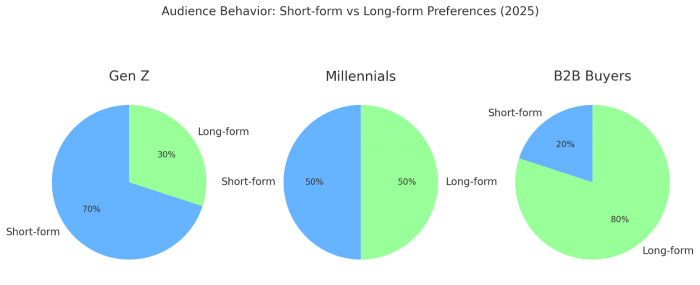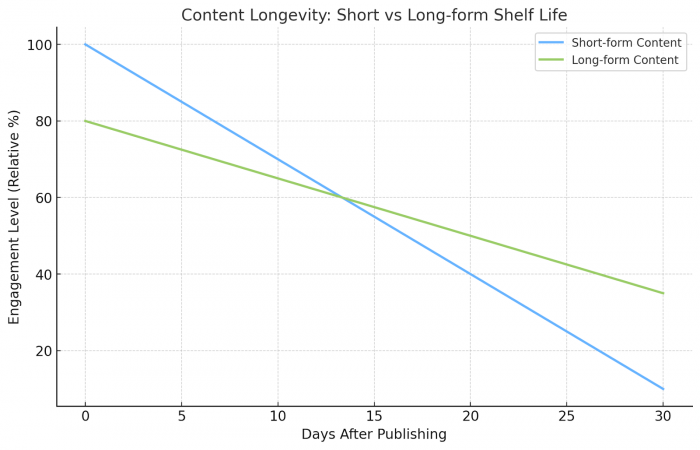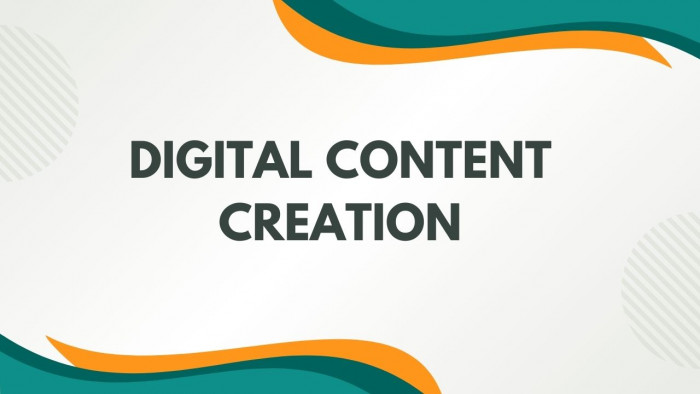Table of Content
- The Scroll Wars
- What Counts as Short-Form and Long-Form Today?
- The Reign of Short-Form: Fast, Viral, Addictive
- Long-Form’s Revival: The Return of Storytelling
- Platform-by-Platform Deep Dive
- Audience Behavior: Who Watches What?
- Business Impact: ROI of Long vs Short
- Creator Economy: How Influencers Use Both
- Hybrid Content Strategy: Content Stacking
- Why Algorithms Treat Short-Form Like Royalty
- The Psychology of Content Consumption
- Case Studies: Brands Winning With Short and Long-Form
- Advertising Differences: CPM, CTR, and ROI
- SEO Impact: Which Format Helps Search Rankings?
- Content Longevity: Shelf Life of Short vs Long
- Trends to Watch in 2025
- Future Outlook: Not Either/Or, But Both
- FAQs
The Scroll Wars
"Attention is the new oil," a marketer once quipped. But in 2025, it feels more like a leaking tap—you either catch it in seconds or it slips away forever.
Every scroll on TikTok, Instagram, or YouTube is a battlefield. On one side, short-form content: fast, addictive, and algorithm-approved. On the other, long-form content: slower, deeper, and built to last.
One promises virality in 30 seconds, the other demands commitment. And the truth? Both are evolving in ways that redefine how we consume, create, and connect online.
What Counts as Short-Form and Long-Form Today?
Short-form is the espresso shot of digital media—quick, sharp, and gone before you realize. Think TikToks, Reels, Shorts, usually under 90 seconds.
Long-form is the five-course dinner. It’s YouTube deep dives, podcasts, LinkedIn newsletters, or TikTok’s new 15-minute uploads. It takes more time, but leaves you fuller.
The funny part? Platforms that were once defined by one format are now blurring lines. TikTok, born on 15-second dances, now supports videos long enough to explain your entire tax return. YouTube, the grand temple of long content, pushes Shorts like candy.
The Reign of Short-Form: Fast, Viral, Addictive
Short-form is still the golden child. Why? Because algorithms love speed and completion.
- Completion rates: It’s easier to finish a 30-second video than a 10-minute one.
- Loop effect: TikTok and Reels auto-loop, boosting watch time without effort.
- Engagement velocity: Short videos get likes and comments quickly, making algorithms think, “Aha, this must be hot.”

Numbers prove it:
- TikTok users spend 95 minutes daily scrolling bite-sized clips.
- Instagram Reels earn 22% more engagement than static posts.
- YouTube Shorts crossed 70 billion daily views in 2024.
For brands, short-form is like digital fast food: easy to make, easy to consume, and perfect for top-of-funnel visibility.
Long-Form’s Revival: The Return of Storytelling
While short-form gets the clicks, long-form builds the trust.
On YouTube, videos longer than 10 minutes generate more ad revenue and loyal subscribers. LinkedIn newsletters have surged, with engagement rates doubling in the last two years. Podcasts now reach over 60% of U.S. adults weekly—proof people commit when content resonates.
Long-form gives space to:
- Educate deeply.
- Tell stories that stick.
- Build authority and credibility.
Short-form might make you famous. Long-form makes you unforgettable.
Platform-by-Platform Deep Dive
Instagram: Reels drive discovery. Carousels and longer clips build saves and shares—perfect for step-by-step guides or storytelling.
TikTok: Now supports 10–15 minute uploads, but the “For You Page” still favors sub-3-minute videos. Still, explainers and tutorials are carving a space.
YouTube: Shorts exploded, but over 40% of watch time is still on long-form. The platform remains the home of tutorials, podcasts, and deep dives.
LinkedIn: Carousels, 2,000+ character posts, and newsletters dominate. It’s where professionals go for substance, not just quick laughs.
Threads & X: Brevity is core, but longer storytelling threads on X and expanded post options on Threads show appetite for both.
Audience Behavior: Who Watches What?

Different audiences lean different ways:
- Gen Z: Scroll-happy, thrives on memes and trends, but obsessed with deep dives when it’s something they care about (gaming, social issues, lifestyle explainers).
- Millennials: Balanced—quick bites on TikTok, but 20-minute YouTube how-tos when they need solutions.
- B2B buyers: No surprise—they want long-form. Case studies, webinars, and LinkedIn essays help them trust before they buy.
The myth of “short attention spans” is misleading. People binge eight hours of Netflix or sit through three-hour podcasts. The real issue? Boring content won’t get finished—short or long.
Business Impact: ROI of Long vs Short
Short-form = quick awareness. Long-form = long-term value.
- Short-form builds reach and spreads messages fast.
- Long-form nurtures audiences and drives conversions.

Smart campaigns mix both: A 20-second teaser Reel sparks interest, followed by a 15-minute case study video that seals the deal.
As one strategist says: “Short-form is the spark, long-form is the fire.”
Creator Economy: How Influencers Use Both
Creators cracked the hybrid model before brands did.
- Short videos attract large audiences.
- Long-form—vlogs, podcasts, newsletters—monetizes those audiences.
- Reels are the pickup line. Long-form is the dinner date.
That’s why today’s top creators don’t pick sides—they build ecosystems.
Hybrid Content Strategy: Content Stacking
The smartest approach? Stacking.
One long-form video can become:
- 3 YouTube Shorts.
- 5 TikTok clips.
- 1 Instagram carousel.
- 1 LinkedIn article.
Short drives discovery. Long builds loyalty. Together, they maximize reach and retention.
And yes, tools like SmartPostly make it seamless—auto-generating captions, hooks, bios, and content calendars so creators can focus on creativity, not staring at a blinking cursor.
Why Algorithms Treat Short-Form Like Royalty
Algorithms chase quick wins.
A 30-second video completed by 90% of viewers ranks better than a 10-minute video watched halfway. Short clips rack up likes and shares at lightning speed, tricking the system into boosting them further.
For platforms, it’s simple math: shorter videos = more swipes = more ad inventory = more money.
The Psychology of Content Consumption
Short-form satisfies our need for instant gratification—quick laughs, trends, and bite-sized knowledge. It feeds dopamine cravings.
Long-form appeals to depth-seeking behavior—when people want to learn, explore, or emotionally connect. It’s less about the scroll and more about the sit-down.
Both tap into different psychological needs. The challenge is knowing when your audience wants the snack and when they’re ready for the meal.
Case Studies: Brands Winning With Short and Long-Form
Duolingo: Hilarious TikToks built brand fame in seconds.
HubSpot: In-depth webinars and long YouTube guides established B2B trust.
Nike: Paired short ad trailers with long behind-the-scenes storytelling, turning campaigns into experiences.
The lesson? Winning brands don’t pick formats—they orchestrate them.
Advertising Differences: CPM, CTR, and ROI
Short ads are cheaper and reach millions. But long ads often drive higher conversions.
- TikTok Spark Ads help brands ride viral waves.
- YouTube’s in-stream long ads capture the attention of viewers who already chose to watch content in-depth.
- Short = awareness. Long = action.
SEO Impact: Which Format Helps Search Rankings?
On YouTube, long-form dominates SEO. Keywords, timestamps, and chapters push videos into search results for years.
On TikTok and Instagram, short-form content optimized with captions and hashtags performs better in discovery and search.
An integrated mix helps brands show up both in social search and in Google/YouTube search ecosystems.
Content Longevity: Shelf Life of Short vs Long

Short-form burns bright but fades fast. TikTok trends often peak within days.
Long-form has staying power. Tutorials, podcasts, and evergreen videos can generate consistent traffic years after publishing.
If short-form is a sparkler, long-form is a campfire.
Trends to Watch in 2025
TikTok’s 15-minute uploads—will audiences adapt?
- Instagram testing episodic “mini-series.”
- LinkedIn newsletters solidifying as a B2B staple.
- YouTube rolling out AI to auto-cut Shorts from long videos.
Threads quietly exploring brand engagement features.
Future Outlook: Not Either/Or, But Both
In 2025, smart creators won’t debate formats—they’ll bridge them.
Short content gets you noticed. Long-form gets you remembered. Together, they create the kind of digital footprint that lasts.
FAQs
Why do algorithms favor short-form?
Because completion rates are higher and scrolling means more ads.
Which format works better for B2B?
Long-form—buyers need substance before making decisions.
Is TikTok really going long-form?
Yes, uploads up to 15 minutes are allowed, though short still dominates.
Should startups start with short or long?
Start with short to build awareness. Use long-form to nurture and convert.


